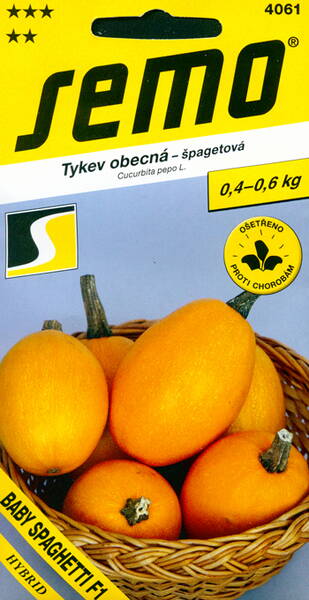An interesting variety of zucchini, the internal structure of the fruit of which is fibrous.
In order to obtain the "spaghetti" effect, the courgettes are harvested after they turn yellow (approximately 120-130 days after germination).
The plant is long-leaved. The fruit is round-cylindrical, weighing 0.4-0.6 kg.
Variety value: high yield, amicable ripening, high culinary qualities. The whole zucchini is dipped in boiling water for 30 minutes.
Then, by cutting in half, remove the seeds and spread the vegetable spaghetti onto a dish. They are used in the same way as classic zucchini.
Care, watering and fertilizing of courgette.
The optimal temperature for germination is +17+20°C. Therefore, the film is not opened, especially at night. After germination, to prevent the squash from stretching out, the air temperature is reduced (at night - to +12+14°C, during the day - to +15+18°C). Then the air temperature is gradually increased. The film is removed from the garden after June 12-15.
Water the courgette regularly, at the root, being careful not to wet the leaves. Before flowering, squash is watered with 8-10 liters per 1 square meter. m once a week.
During fruiting, plants are watered more often, every 2-3 days, at the rate of 10-12 liters per 1 square meter. m or once a week 15-20 liters per 1 sq. m.
The water temperature for irrigation should be +22+25°C.
Attention! Watering with cold water leads to massive rotting of young ovaries. In addition, frequent watering can expose the root system.
In this case, the bed is mulched with a mixture of humus and peat (layer 3-5 cm).
Attention! Loosening and hilling cannot be carried out. This treatment leads to damage to the roots. During the growing season, the courgetteis fed several times.
The first feeding is carried out before flowering. A 0.5-liter jar of mullein and a tablespoon of nitrophoska are diluted in 10 liters of water, watered at the rate of 1 liter per 1 plant.
The plants are fed the second time during flowering. A glass of wood ash and a tablespoon of complete fertilizer are diluted in 10 liters of water, watered at the rate of 5 liters per 1 square meter. m.
The third time the plant is fed during fruiting. In 10 liters of water, dilute a tablespoon of double superphosphate, potassium sulfate and urea, water at the rate of 3 liters per 1 square meter. m.
During fruiting, make two foliar feedings with urea solution with an interval of 10-12 days.
A tablespoon of urea is diluted in 10 liters of water and the plants are sprayed with this solution, spending 1 liter per plant.
Don't pinch the courgettei. However, as the bush grows, the influx of sunlight to the center of the plant decreases greatly. Therefore, it is recommended to remove 2-3 leaves from the middle of the bush and thereby restore a favorable light regime.
To attract insects to courgette flowers, it is recommended to sprinkle the plants with the following composition in the morning: dissolve a teaspoon of honey in a glass of water.
During flowering, artificial pollination can also be carried out. To do this, they pick a male flower, tear off its petals and apply pollen to the pistil of the female flower. With the help of one male flower, 2-3 female flowers are pollinated.
Harvest.
The harvest begins when the fruits reach consumer ripeness, that is, when their length reaches 15-20 cm and diameter - 5-7 cm.
The fruits grow to this size 8-12 days after the ovaries appear. At this time, the stalk is juicy, not roughened, and the fruits can be easily cut with a knife when harvesting.
With massive fruit set and favorable external conditions, courgette grows rapidly. During this period, it is necessary to collect the fruits daily, preventing them from overgrowing.
Attention! Overgrown fruits retard the growth and development of young ovaries. Courgetteare stored at 0+2°C for two weeks.
Storage for more than 12 days deteriorates the quality of the fruits, they become rougher.
The fruits are stored in the basement or under normal room conditions until March-April.











